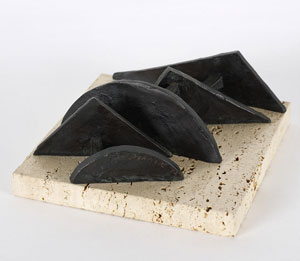6.17.24 — Before and After
The finest postwar sculptor after David Smith would have hated the compliment. Dorothy Dehner was tired of coming after Smith, and she put off sculpture as long as she could, until after their divorce. She made the most of it, too, and she kept getting stronger until her death in 1994. Black steel fins in loose parallel will catch anyone’s eye from across the room, at Berry Campbell through June 22.
So they must, because a show of just over forty works starts instead with a still life from 1936, thirty-six years before. It makes clear just how much she drew on early Modernism—and how much she owed to her love of painting and drawing. She did not so much keep changing as keep building on what she knew with each successive discovery.  She was an artist of her time in changing times. Still, Dehner comes as a discovery even now. She also comes with an all too familiar story.
She was an artist of her time in changing times. Still, Dehner comes as a discovery even now. She also comes with an all too familiar story.
You know the tale. A woman close to the leading artist in his generation and his medium feels his influence, but feels stifled by his dark moods and mammoth work. You know it from Lee Krasner and Jackson Pollock in painting, although Krasner continued to exhibit without a break. You may know it, too, from Sonia Delaunay and Sophie Taeuber-Arp—although the first and Robert Delaunay were true collaborators, while the second and Jan Arp had independent careers. Dorothy Dehner has appeared before in other acts of rediscovery, of women in abstraction and, at her gallery just this year, women who persevered. One could take for granted her status without quite knowing what she did.
Dehner was born in 1901, five years before David Smith, and long outlived him. And he himself was only hitting his stride when they divorced, in 1952, like Abstract Expressionism itself. Besides, when it comes to sculpture, pretty much everyone comes after David Smith. She said that one sculptor is plenty for a family, but one can feel her restlessness. Still, she had studied sculpture and set it aside well before their marriage, finding her education stifling as well. Apparently Dehner found a lot of things stifling, which is not to say that she was wrong.
Already she had found her own way into art and to New York. She left the Bay Area to become an actress. Not that her sculpture is narrative or theatrical. Anything but, and yet she came to painting and sculpture as part of a broader creative community. She mingled, back when artists loved to talk, and befriended Louise Nevelson—another reason to take up sculpture. Nevelson, in turn, introduced her to John Cage, who inspired assemblage from the 1970s based on the I Ching.
She gave up acting because she found that stifling, too. Who needs to follow someone else’s script and direction? Still, she was always learning from others and looking back. That opening painting recalls still life in Cubism, but its soft colors and minimal disruptions suggest an interest more in composition than in the enigmas of perception and art. She was never above adding relief elements to Smith’s planes.
She loved drawing as a foundation for art, just as the old school taught. Her first move after divorce was not to sculpture after all, but to drawings and prints—and they, too, look back. A fine ink line connects the dots against an atmospheric background, much like Paul Klee in paint. Her sculpture soon after includes both light bronze and carved wood, and one could mistake the I Ching series from a distance for drawing itself. She was also not above abstracting from the world about her. One work takes its rhythms from the curve of a suspension bridge arcing over the verticals of a New York skyline.
She titled her black fins Blackbirds, and they rest on the floor—just as earlier work rests comfortably on a shelf. She has pared back David Smith, with his guardians and totems, to the elegance of Constantin Brancusi. She is also less concerned for Smith’s industrial welding than for the object, which must have allowed her to work with assistants. For all her backward eye, her most memorable work dates from her seventies and eighties, when many a welder is short of strength. Nevelson’s nightmares and the stifling are long gone. She can finally breathe easily, in black steel on a travertine base.
Read more, now in a feature-length article on this site.